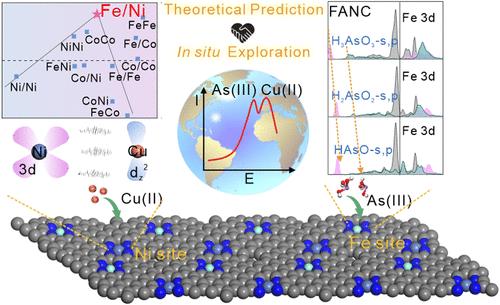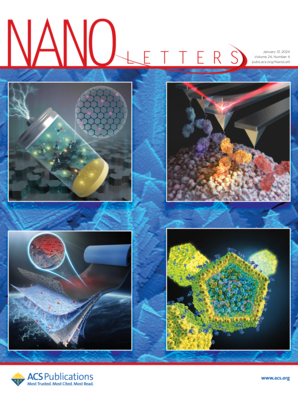High-Throughput Screening of Selective Bimetallic Atomic Catalysts for Self-Adaptive Matched Electrochemical Reduction
IF 9.6
1区 材料科学
Q1 CHEMISTRY, MULTIDISCIPLINARY
引用次数: 0
Abstract
Due to the impediments of spatial and temporal resolution, the comprehension of microdynamic processes still remains limited, which seriously hinders the advancement of catalyst regulating and the expansion of application. Herein, the efficient selective bimetallic atomic electrode interface was cultivated via high-throughput screening, achieving self-adaptive parallel electrochemical reduction of Cu(II) and As(III). Combined in situ X-ray absorption fine structure (XAFS) spectroscopy and coordination field theory verified the Ni–Cu specific energy level matching promoted by permitted d–d transition and also reproduced the microscopic dynamic reduction process. Additionally, it was discovered that the Fe–As specific bonding and energy barrier of the smallest potential-determining step (1.40 eV) were derived from the linear shift of the main s and p peaks of the key arsenic intermediates to the high-energy orbital. This work offers insights into transient reaction dynamics by in situ methods and theoretical simulations, which broadens the design of multisite atomic catalysts.

求助全文
约1分钟内获得全文
求助全文
来源期刊

Nano Letters
工程技术-材料科学:综合
CiteScore
16.80
自引率
2.80%
发文量
1182
审稿时长
1.4 months
期刊介绍:
Nano Letters serves as a dynamic platform for promptly disseminating original results in fundamental, applied, and emerging research across all facets of nanoscience and nanotechnology. A pivotal criterion for inclusion within Nano Letters is the convergence of at least two different areas or disciplines, ensuring a rich interdisciplinary scope. The journal is dedicated to fostering exploration in diverse areas, including:
- Experimental and theoretical findings on physical, chemical, and biological phenomena at the nanoscale
- Synthesis, characterization, and processing of organic, inorganic, polymer, and hybrid nanomaterials through physical, chemical, and biological methodologies
- Modeling and simulation of synthetic, assembly, and interaction processes
- Realization of integrated nanostructures and nano-engineered devices exhibiting advanced performance
- Applications of nanoscale materials in living and environmental systems
Nano Letters is committed to advancing and showcasing groundbreaking research that intersects various domains, fostering innovation and collaboration in the ever-evolving field of nanoscience and nanotechnology.
 求助内容:
求助内容: 应助结果提醒方式:
应助结果提醒方式:


